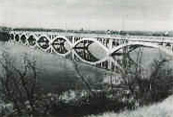
The Tenth Street Bridge, completed in 1920, provided a critical connection between Great Falls and outlying communities to the north, particularly the Black Eagle community directly across the Missouri River. The bridge reflects the "vision" of Paris Gibson, the founder of Great Falls, who had great influence on determining the physical plans for the city.
Gibson spearheaded the creation of The Tenth Street Bridge, which continues to make a statement about the pride and optimism of the community during the early years of this century. The Tenth Street Bridge is of engineering significance as the longest open-spandrel, ribbed-arch, concrete bridge in Montana. The bridge design was produced by the collaboration of Ralph Adams, a structural engineer from Spokane, and George Shanley, a prominent Great Falls architect.
Shanley made Great Falls his permanent home in 1907 and over several decades he designed numerous buildings throughout Montana, and beyond, in addition to adding over 40 prominent buildings in Great Falls including the Rainbow Hotel, First National Bank Building, YMCA Building and many others.
When the Tenth Street Bridge was completed, the Great Falls Tribune described the Bridge as "an imposing structure of sweeping arches ... a carved monument above the water." The sweeping arches of the Tenth Street Bridge have inspired artists and photographers, delighted the eyes and served the traveling public for seventy-five years. In 1971, the structure was identified as a top priority for replacement by the State of Montana and Cascade County. The bridge was closed in 1975, for about a year, to make temporary repairs to the bridge deck. In 1986, the city and county governments escalated efforts to demolish the 1920 bridge and replace it with a new bridge on a slightly different alignment. The Tenth Street Bridge had been determined eligible for listing on the National Register of Historic Places several years prior to that decision, and its demolition became the subject of much debate through 1988, when the Advisory Council on Historic Preservation concluded that there were "prudent and feasible alternatives" to demolition. Although the bridge was structurally sound, and in spite of pressure from federal and state agencies and from local citizens, plans were made to build a new bridge at a site immediately upstream, and demolish the longest multi-span, open-spandrel concrete bridge in Montana.
Much has happened in Great Falls and the nation since the 1988 bridge hearings. There is a growing movement to identify, protect and promote the community's historic resources. Three districts have been listed in the National Register of Historic Places. Great Falls/Cascade County has established a Preservation Commission which is in full agreement that The Tenth Street Bridge is important to the Great Falls landscape and is worthy of preservation. The River's Edge Trail, a walk/bike facility has been added to the landscape along the south bank of the Missouri River offering the potential for active pedestrian use of the bridge. Trail use has grown considerably, and a north bank trail is now in place.
In the 1980s, when plans were made for a new bridge, changes in the law which govern the nation's transportation system had not occurred. The 1991 Intermodal Surface Transportation Efficiency Act offers additional recognition and protection to historic resources, walk/bike trails, and scenic byways, and introduced changes in transportation planning practices all geared to "make transportation part of the livable-community process." Two engineering studies confirmed the Advisory Council's 1988 determination that "prudent and feasible alternatives" to demolition remain for the bridge. The Tenth Street Bridge is not only historically and aesthetically important to the City of Great Falls, it also serves as an emotional symbol to the community as evidenced by the level of support that continued to exist even after the public was told that the bridge was marked for demolition. Over 5,000 residents signed petitions to "Save The Bridge"!